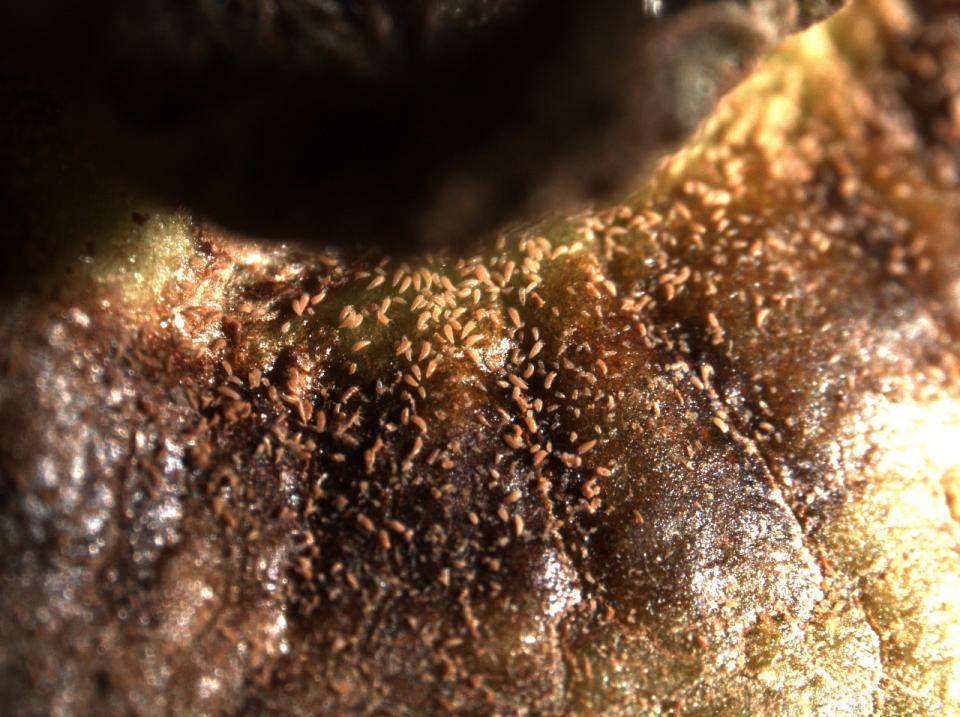
There are a number of insect and/or mite pests that may attack greenhouse-grown tomatoes including the tomato russet mite (Aculops lycopersicii). Adults of this mite are less than 0.3 mm in length and are robust, wedge-shaped, and somewhat tapered, resembling cigars with the head and legs located on one end of the body. They also possess two pairs of legs (four total), which is very different from other mites that normally have eight legs. Tomato russet mite varies in color from translucent, yellow, brown, or tan, to pink. Under a microscope (100X power), heavy infestations of the tomato russet mite may appear as dust or mold.
Females lay eggs on leaf undersides, on leaf petioles, or on stems near the lower portions of plants. The nymphs that hatch from eggs, which look similar to adults, tend to congregate on leaf edges. Nymphs eventually transition into adults. The life cycle from egg to adult is usually completed in one week under warm temperatures (≥80ºF or 26ºC). Lower plant portions that are heavily-infested or damaged may cause mites (both adults and nymphs) to migrate to new, young leaves. Tomato russet mite populations may spread from plant-to-plant via wind currents or when plant leaves are touching. This mite prefers warm, dry environmental conditions, and may be most abundant from April through September.
Tomato russet mite mainly feeds on greenhouse and/or outdoor grown vegetables in the Solanaceae family including eggplant, peppers, potatoes, and tomatoes. Both the adults and nymphs possess piercing-sucking mouthparts, and feed primarily on stems and the undersides of lower leaves, which causes leaf bronzing. In addition, leaves may turn yellow, wither or curl upward, dry-up, and fall off plants. The damage caused by tomato russet mite typically starts on the lower leaves, and then progresses upward. The type of damage caused by this mite may resemble a nutritional deficiency, plant disease, or water stress.
To reduce potential problems with tomato russet mites it is important to remove weeds from the garden, and from within and around the greenhouse exterior. Many weeds are a source of infestation especially those in the nightshade or potato family such as field bindweed (Convulvulus arvensis) and jimson weed (Datura stramonium). Also, be sure to inspect plants routinely, which may prevent outbreaks from occurring. Pesticides or miticides that may have activity on tomato russet mite include sulfur, endosulfan (Thiodan), and petroleum-based horticultural oils. Be sure to thoroughly spray leaf undersides because this is where most of the life stages (eggs, nymphs, and adults) are located. It is important to read the label to determine if tomato russet mite populations may actually be “controlled” or suppressed by a particular material. Heavily infested plants should be discarded immediately.
There are several predatory mites that are commercially available, which may feed on populations of tomato russet mite. Be sure to consult with a biological control supplier for more information. So, be on the look-out for this mite to ensure that you have a viable crop of “juicy” tomatoes during the season.
Dr. Raymond A. Cloyd is a Professor and Extension Specialist in Ornamental Entomology/Integrated Pest Management in the Department of Entomology at Kansas State University. He can be contacted at:
Dr. Raymond A. Cloyd
Kansas State University
123 Waters Hall
Manhattan, KS 66506
P – 785.532.4750
Email: rcloyd@ksu.edu
Related Articles & Free Email Newsletter
How To Deal With Caterpillar Pests Using Bacillus thuringiensis spp. kurstaki




Comment here